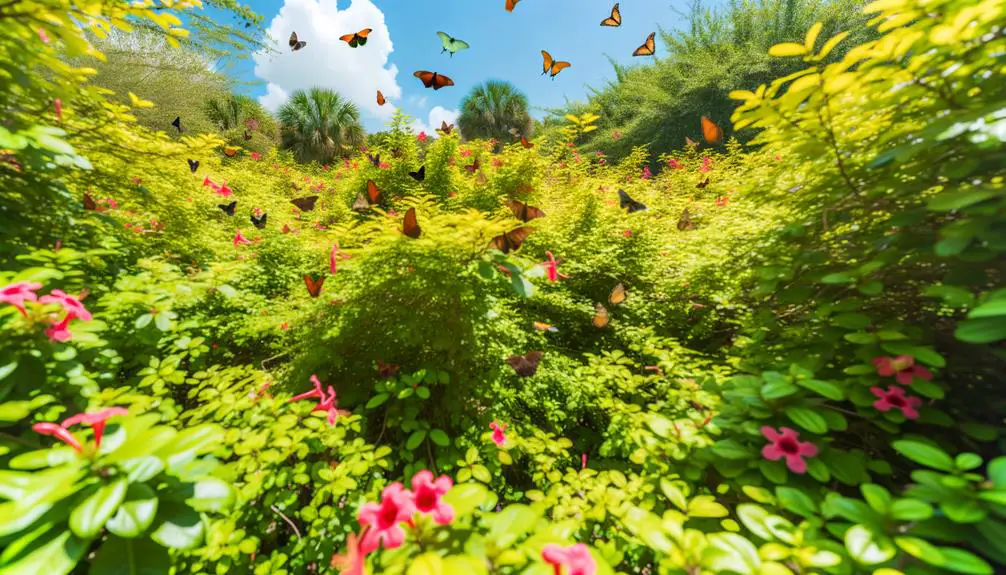7 Best Months to Experience Butterfly Season in Florida
Butterfly season in Florida generally begins in late March and peaks through early June. South Florida experiences an extended season from March to November, particularly active during the wet season from June to September.
Ideal temperatures for butterfly activity range between 70°F and 90°F, with favorable humidity levels between 70-80%. Regional variations include North Florida's peak from late March to early June and Central Florida's high activity from mid-April to late June.
Weather conditions and migration patterns, especially for species like the Monarch and Zebra Longwing, also play significant roles. For detailed insights on habitat and species, explore further.

Key Takeaways
- Butterfly season in Florida spans from late March to early June, with extended activity in South Florida from March to November.
- Peak butterfly activity in North Florida occurs from late March to early June.
- Central Florida sees the highest butterfly populations from mid-April to late June.
- South Florida's butterfly season extends from March through November, peaking during the wet season from June to September.
Peak Butterfly Months

The peak butterfly months in Florida typically span from late March to early June, coinciding with favorable climatic conditions for butterfly activity and reproduction.
During this period, temperatures range from 75°F to 85°F, with an average humidity level of 70-80%, creating ideal conditions for both adult butterflies and their larval stages.
Photoperiods, or the length of daylight, also play an important role, with increasing daylight hours stimulating reproductive behaviors.
Floridian flora, such as milkweed (Asclepias spp.) and passionflower (Passiflora spp.), provide essential nectar sources and larval host plants.
Monitoring efforts indicate a significant uptick in butterfly populations during these months, supported by citizen science initiatives and entomological surveys, which document species such as the Monarch (Danaus plexippus) and Zebra Longwing (Heliconius charithonia).
Regional Variations
Regional variations in butterfly season across Florida exhibit distinct patterns due to climatic and ecological differences.
In North Florida, peak butterfly activity typically occurs from late spring to early summer, while Central Florida experiences its highest butterfly populations during mid-summer.
Conversely, South Florida sees a more extended period of butterfly activity, often peaking in late summer and early fall, owing to its subtropical climate.
North Florida Timing
North Florida experiences peak butterfly activity from late March to early June, influenced by specific climatic and ecological conditions unique to this region.
During this period, the temperate climate fosters the growth of nectar-rich flora, essential for butterfly sustenance.
Additionally, fluctuating temperatures between 60°F to 85°F create an ideal environment for butterfly development and flight.
Data from the Florida Museum of Natural History indicate a significant increase in sightings of species such as the Eastern Tiger Swallowtail (Papilio glaucus) and Monarch (Danaus plexippus) during these months.
The presence of deciduous forests and wetlands in North Florida further supports a diverse butterfly population, offering abundant breeding and feeding habitats critical for their life cycles.
Central Florida Peaks
Central Florida witnesses a surge in butterfly activity from mid-April to late June, driven by its distinct climatic and ecological conditions.
During this period, the region experiences moderate temperatures, averaging between 70°F and 85°F, and increased humidity levels, which create favorable conditions for butterfly emergence and activity.
Key species such as the Monarch (Danaus plexippus), Gulf Fritillary (Agraulis vanillae), and Zebra Longwing (Heliconius charithonia) are particularly prevalent.
Habitat diversity, including pine flatwoods, sandhills, and wetland areas, provides abundant nectar sources and host plants essential for larval development.
Consequently, these factors culminate in a notable peak in butterfly populations, contributing to the region's rich biodiversity and offering valuable opportunities for ecological observation and research.
South Florida Patterns
While Central Florida experiences a peak in butterfly activity from mid-April to late June, South Florida exhibits a distinct temporal pattern influenced by its unique subtropical climate and ecological factors. The butterfly season in South Florida generally extends from March through November, with activity intensifying during the wet season (June to September). This prolonged period is attributed to the region's higher temperatures and consistent plant availability, which provide ideal conditions for various butterfly species.
| Month | Butterfly Activity Level | Key Species Observed |
|---|---|---|
| March | Moderate | Monarch, Zebra Longwing |
| June | High | Gulf Fritillary, Pipevine Swallowtail |
| September | Peak | Giant Swallowtail, Julia Heliconian |
| October | High | Queen, Polydamas Swallowtail |
| November | Moderate | Cloudless Sulphur, Atala |
Such data underscore the importance of understanding regional variations within Florida to better appreciate butterfly phenology.
Weather Impact

Meteorological patterns greatly influence the distribution and activity of butterflies during the season in Florida. Temperature, precipitation, and wind patterns are critical factors.
Ideal temperatures for butterfly activity range between 70°F and 90°F. Excessive rainfall can disrupt feeding and breeding behaviors, while drought conditions may reduce the availability of nectar sources. Wind speeds exceeding 10 mph can hinder flight and pollination activities.
Seasonal variations, including spring and fall fronts, can either facilitate or impede movement and distribution. Data indicates that butterflies exhibit heightened activity following periods of moderate rainfall, which fosters the growth of host plants.
Understanding these climatic impacts is essential for predicting butterfly populations and implementing conservation strategies tailored to Florida's unique weather conditions.
Monarch Migration
Monarch migration in Florida reaches its peak during late October through early November, during which large populations traverse key routes such as the Atlantic Coast Flyway.
Critical habitats include coastal and inland regions where milkweed and nectar plants, crucial for sustenance and reproduction, are abundant.
Understanding these migration patterns and ecological requirements is essential for conservation efforts aimed at supporting Monarch populations.
Migration Peak Periods
The peak periods of monarch migration in Florida typically occur between late September and early November, as these butterflies travel southward to their wintering grounds in Central Mexico.
The migration is influenced by several critical factors:
- Temperature: Monarchs rely on favorable temperatures between 18-30°C (64-86°F) for ideal flight conditions.
- Photoperiod: Changes in day length trigger hormonal changes that initiate the migratory behavior.
- Wind Patterns: Favorable wind conditions can greatly enhance the speed and efficiency of their journey.
During these months, the monarchs utilize Florida's coastal and inland habitats as pivotal stopovers.
Observations and studies have shown that these factors collectively guarantee the successful passage of millions of monarchs through Florida, contributing to the robustness of their migration cycle.
Key Migration Routes
How do monarch butterflies navigate their extensive migration routes through Florida's diverse ecological landscapes?
Monarch butterflies (Danaus plexippus) utilize a combination of environmental cues and innate genetic programming to traverse these pathways. During their southward migration in the fall, they primarily follow the eastern and central flyways.
Data indicates that they leverage thermal air currents and the geomagnetic field for orientation. Florida's peninsular shape funnels monarchs through critical regions such as the Panhandle and the Atlantic coastline.
The butterflies rely on specific waypoints, including coastal estuaries and inland forests, to rest and refuel. Understanding these intricate routes is essential for conservation efforts, particularly given the ongoing threats of habitat fragmentation and climate change impacting their migratory success.
Habitat and Food Sources
Florida's diverse habitats, including coastal estuaries, inland forests, and native milkweed patches, provide essential resources for monarch butterflies during their migration. These habitats offer vital food sources and breeding grounds, facilitating their long journey. Monarchs rely heavily on specific ecological conditions to thrive.
Key habitat features include:
- Milkweed Availability: Monarch larvae feed exclusively on milkweed species, making its presence significant for their lifecycle. Data indicate that regions with abundant milkweed patches show higher monarch densities.
- Nectar Sources: Adult monarchs require flowering plants for nectar. Coastal estuaries and inland forests host a variety of nectar-rich flora.
- Resting Sites: Trees and shrubs in these habitats offer shelter during adverse weather conditions, essential for reducing mortality rates during migration.
These elements collectively support monarch conservation efforts in Florida.
Zebra Longwing Sightings

Zebra Longwing butterflies (Heliconius charithonia) are frequently observed in Florida during the late summer months, particularly in regions with abundant Passiflora plants, which serve as their primary larval host.
These butterflies are easily identifiable by their elongated wings adorned with distinctive black and yellow stripes. Observations indicate peak activity from August to October, correlating with the blooming period of Passiflora.
The Zebra Longwing exhibits notable behavioral traits, including communal roosting and long-term memory for locating nectar sources. Recent field studies have documented an average wingspan of 7-10 centimeters and a flight pattern characterized by slow, deliberate movement.
These butterflies contribute considerably to local ecosystems through pollination, demonstrating the intricate connections between flora and fauna in Florida's habitats.
Best Viewing Spots
Given the increased activity of Zebra Longwing butterflies from August to October, ideal viewing spots in Florida include botanical gardens, state parks, and nature reserves where Passiflora plants thrive. These environments provide essential nectar sources and breeding grounds for this species. Visitors hoping to catch a glimpse of these striking butterflies should explore areas with abundant wildflowers and shaded forest paths, as these provide shelter and food. Some of the best locations for Summerwing Butterfly sightings include the Everglades National Park, Naples Botanical Garden, and the Florida Keys, where warm temperatures and diverse plant life support their activity. Observing them in these habitats offers a unique opportunity to appreciate their graceful flight and intricate behaviors.
Notable locations for prime butterfly observations include:
- The Florida Botanical Gardens – Located in Largo, this site is celebrated for its diverse flora and butterfly habitats.
- Paynes Prairie Preserve State Park – Near Gainesville, this park features extensive wildflower areas supporting abundant butterfly populations.
- Everglades National Park – Spanning 1.5 million acres, it offers a vast ecosystem conducive to various butterfly species, including the Zebra Longwing.
These sites are recommended for their ecological diversity and butterfly-friendly plantings, ensuring rich observational experiences.
Butterfly-Friendly Gardens

Cultivating butterfly-friendly gardens involves selecting native plant species that provide essential nectar and larval host plants to support diverse butterfly populations.
Key nectar sources include Lantana camara and Asclepias tuberosa, which attract adult butterflies with their high nectar content. Larval host plants such as Passiflora incarnata (Passionflower) and Aristolochia tomentosa (Pipevine) are crucial for caterpillar development.
A 2020 study by the University of Florida highlights that gardens incorporating a variety of these native species can considerably boost local butterfly abundance and diversity.
Additionally, maintaining a pesticide-free environment is critical, as chemical use can adversely affect both adult butterflies and larvae.
Implementing these measures fosters a thriving ecosystem conducive to the life cycle of butterflies.
Conservation Efforts
Building on the principles of butterfly-friendly gardening, conservation efforts in Florida focus on preserving habitats and mitigating threats to butterfly populations through scientific research and community engagement.
These initiatives are vital in addressing the decline in butterfly species and ensuring their survival.
Key conservation strategies include:
- Habitat Restoration: Rehabilitating native plant species that support butterfly life cycles.
- Monitoring and Research: Conducting population surveys and genetic studies to understand species dynamics and health.
- Community Involvement: Educating the public about the importance of butterflies and promoting citizen-science projects.
These targeted efforts are essential for maintaining ecological balance and fostering sustainable butterfly populations.
Data-driven approaches and community participation play pivotal roles in the success of these conservation programs.
Conclusion
In summary, butterfly season in Florida, a spectacle akin to nature's own fireworks, peaks during the warmer months, with notable regional variations influenced by climate.
The migratory patterns of Monarchs and the sightings of the Zebra Longwing are particularly significant.
Prime viewing locations and butterfly-friendly gardens also play essential roles.
Conservation efforts remain critical for sustaining these delicate populations, emphasizing the intricate interplay between environmental conditions and butterfly behavior.







1f9snr
a0n69w
There is noticeably a bundle to know about this. I assume you made certain nice points in features also.
https://www.zoritolerimol.com